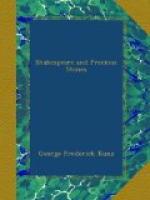[Footnote 8: Rare word, only known in this passage. Century Dictionary gives “invisible”, “unseen”, “uninspected”, noting that some commentators suggest “inspected”, “tried”, “investigated".]
Had Shakespeare felt much interest in the lore of gems, he had before him most of the then available material in a book of which he seems to have made some use.[9] This was an English rendering of the “De Proprietatibus Rerum” of Bartholomaeus Anglicus (fl. ca. 1350), by Stephan Batman, or Bateman (d. 1587), an English divine and poet, who in the later years of his life was chaplain and librarian to the famous Archbishop Parker, and thus had free access to the latter’s fine library. His rendering, published in 1582, bears the following quaint title: “Batman uppon Bartholome his Book De Proprietatibus Rerum”; it was published in 1582, and appears to have been widely read in England among those still interested in the learning of the scholastic period. A much earlier English version, made by John of Trevisa in 1396, was published by Wynkyn de Worde in 1495, and is considered to be the finest production of his press.[10]
[Footnote 9: See H.R.D. Anders, “Shakespeare’s Books”, Berlin, 1904, pp. 238-248, and the New Shakespeare Soc. Trans., 1877-79, pp. 436 sqq.]
[Footnote 10: In the author’s library is a fourteenth century MS. of the “De Proprietatibus Rerum”, which belonged to the Carthusian Monastery of the Holy Trinity, at Dijon.]
A rarely noted source for some of Shakespeare’s knowledge regarding curious customs has been sought in the rambling treatise on heraldry written by Gerard Legh and issued, in 1564, under the title: “Accedens of Armorie” (approximately, Introduction to Heraldry). This is cast in the form of a dialogue between Gerard the Herehaught (Herold) and the Caligat Knight, the latter term designating an inferior kind of knight with no claim to nobility; indeed, an old writer renders it “a souldior on foot”. The writer manages to weave in much material slightly or not at all connected with his main theme. Legh was the son of a Fleet Street draper. He seems to have studied a variety of subjects and gathered together many scraps of curious information. He died of the plague, October 13, 1563. His book went through several editions during Shakespeare’s lifetime. Following the first edition of 1562 came successive ones in 1576, 1591, 1597, and one bearing the imprint of J. Jaggard in 1616. The author is believed to have been intentionally obscure in his treatment of heraldic questions lest he might earn the ill-will of the College of Arms by violating certain of their privileges.
While both Shakespeare and his great contemporary Cervantes died on April 23 of the year 1616, it strangely happens that Cervantes had been dead ten days when Shakespeare expired. This apparent paradox is due to the fact that while in Spain the Gregorian calendar had already been introduced, the “Old Style”, or Julian reckoning, was still used in England; indeed, it was not totally abandoned until 1752, in the reign of George II, 170 years after the first use of the Gregorian reckoning on the Continent. In the seventeenth century the error to be corrected amounted to ten days, so that Shakespeare’s death, under the New Style, occurred on May 3, while Cervantes died on April 13 of the Old Style.




